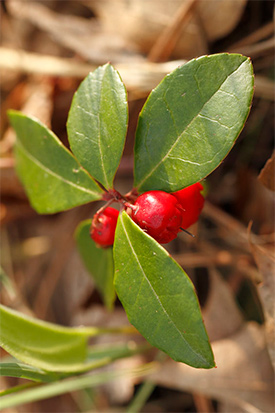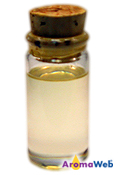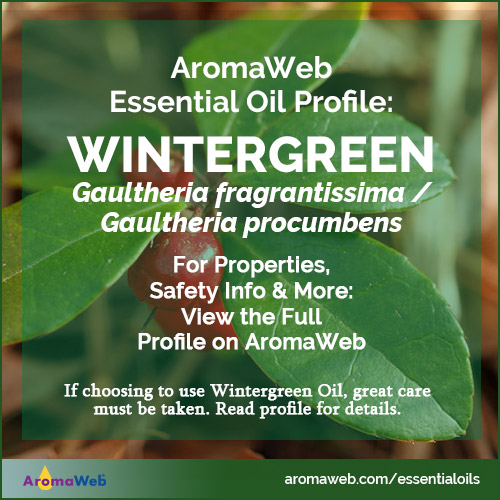Wintergreen Essential Oil
Gaultheria fragrantissima or Gaultheria procumbens
Description

Wintergreen is sometimes mistakenly believed to be a member of the mint family partly because it possesses a strong, crisp, mint-like aroma.
Wintergreen Essential Oil is typically comprised of at least 96% methyl salicylate, an ester that can be toxic when not used with great care.
Wintergreen Essential Oil is praised for its ability to reduce pain and inflammation. However, it must be used sparingly and with immense caution as numerous reports of poisoning have occurred. See the Safety Information section below for more details on contraindications.
Salvatore Battaglia writes that Wintergreen Essential Oil is typically produced by first soaking wintergreen leaves in warm water. Interestingly, Battaglia and other sources indicate that methyl salicylate is not present in fresh wintergreen leaves. When the leaves are soaked in water, the methyl salicylate is produced as a result of the decomposition of the leaves. If choosing to use Wintergreen Essential Oil, be certain to purchase the oil from a highly reputable company because synthetic methyl salicylate is sometimes passed off as pure Wintergreen Essential Oil. [Salvatore Battaglia, The Complete Guide to Aromatherapy (Australia: The Perfect Potion, 2003), 324.]
Wintergreen Essential Oil Benefits and Uses
- Inflammation
- Pain Management
- Rheumatoid Arthritis
Source: Salvatore Battaglia, The Complete Guide to Aromatherapy (Australia: The Perfect Potion, 2003), 324.
Botanical Name
Gaultheria fragrantissima or Gaultheria procumbens

Plant Family
Common Method of Extraction
Water or Steam Distillation
Plant Part Typically Used
Color
Clear to Pale Yellow
Consistency
Thin
Perfumery Note
Top
Strength of Initial Aroma
Strong
Aromatic Description
Wintergreen Essential Oil smells crisp, fresh, woody and sweet. It possesses a birch-like aroma.
Major Constituents
- Methyl Salicylate: 96.0-99.5%
Source: Private Communication: Vossen, 2004. E. Guenther, The Essential Oils, Volumes 1-6. Van Nostrand, New York, 1949-1952. Sources cited in Robert Tisserand and Rodney Young, Essential Oil Safety (Second Edition. United Kingdom: Churchill Livingstone Elsevier, 2014), 469.
Wintergreen Essential Oil Safety Information
Use sparingly if at all. Numerous reports of poisoning have occurred. Tisserand and Young warn that Wintergreen Essential Oil poses a hazard for toxicity, drug interaction, it can inhibit blood clotting, and high doses are teratogenic (harmful to fetuses and embryos). Avoid use of Wintergreen with children, during pregnancy and breastfeeding and by those taking anticoagulant medication. They recommend a dermal maximum of 2.4% and advise to use with caution with skin that is sensitive or damaged. Reading Tisserand and Young's full profile is recommended. [Robert Tisserand and Rodney Young, Essential Oil Safety (Second Edition. United Kingdom: Churchill Livingstone Elsevier, 2014), 469.]
General Safety Information
Do not take any oils internally and do not apply undiluted essential oils, absolutes, CO2s or other concentrated essences onto the skin without advanced essential oil knowledge or consultation from a qualified aromatherapy practitioner. For general dilution information, read AromaWeb's Guide to Diluting Essential Oils. If you are pregnant, epileptic, have liver damage, have cancer, or have any other medical problem, use oils only under the proper guidance of a qualified aromatherapy practitioner. Use extreme caution when using oils with children and be sure to first read the recommended dilution ratios for children. Consult a qualified aromatherapy practitioner before using oils with children, the elderly, if you have medical issues or are taking medications. Before using this or any essential oil, carefully read AromaWeb's Essential Oil Safety Information page. For in-depth information on oil safety issues, read Essential Oil Safety by Robert Tisserand and Rodney Young.
Shelf Life
Important Information About the Profiles
The essential oil information provided on AromaWeb is intended for basic educational purposes only. The references to safety information, test results, constituents and percentages is generalized information. Essential oils can vary greatly in composition. The data is not necessary complete and is not guaranteed to be accurate. The essential oil photos are intended to represent the typical and approximate color of each essential oil. However, essential oil composition and color can vary based on harvesting, distillation, age of the essential oil and other factors. Profiles for several CO2 Extracts and absolutes are included within the directory, and are denoted as such.
